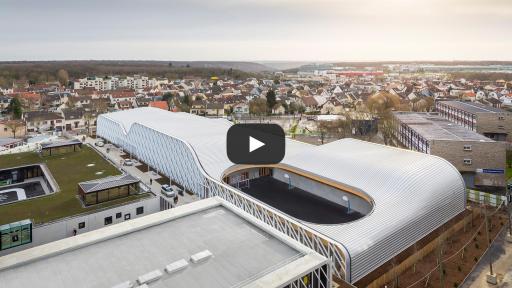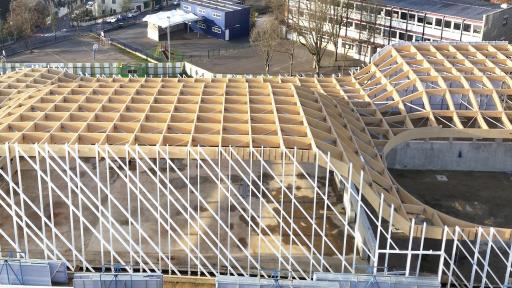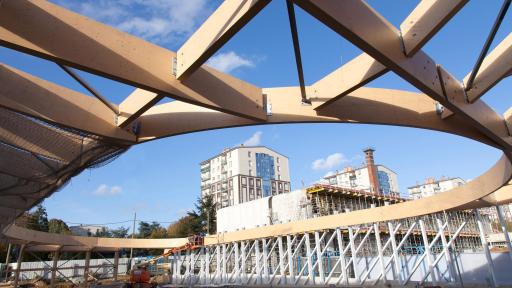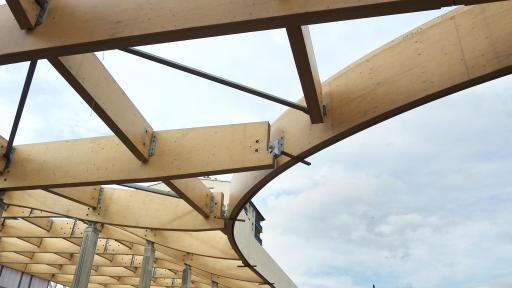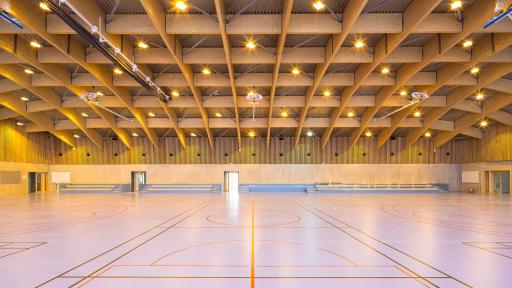Urban sports centre with unforeseen wooden curves
The innovative use of prefabricated wood products enabled an ambitious architectural vision to be fulfilled
The new Clamart Sports Centre is ‘an authentic city of sports’ with a shape designed to follow the curves of the landscape. The design work was based on the definition of the architectural concept by Gaétan Morales and his team from Gaëtan Le Penhuel architect agency. The technical solution linked the façade and roof together in a continuous structure. The sports complex includes a gym, a martial arts dōjō, a track and field area, and a tennis court – all in one floor.
"This project is really exceptional, not just because of its size but also because of its shape. With its curves, unusual dimensions and wide opening in the roof for the track and field area, very few pieces of wood used were identical”, Antoine Roux from the Clamart project’s engineering contractor Charpente Concept explains.
Due to its complex geometry, the roof and framework design of the Clamart Sports Centre posed advanced technical and aesthetic challenges, such as the double curve in certain areas of the roof. Metsä Wood’s Kerto® LVL replaced glulam, which is generally used for building long curved beams.
Extensive 3D design work was the starting point
In line with the local authority's wishes, a primary architectural objective for the Clamart Sports Centre was to recreate a link between two highly contrasting urban environments: a residential zone of detached houses, and a district of tower blocks. The entire building was sized and designed in 3D, taking 3,000 hours of design work and producing the 4,000 construction drawings that can now be reused at different scales.
"We discussed structural efficiency and produced analyses with our modelling and calculation systems to identify the most appropriate solution. In particular, we worked extensively on the layout. All the design process was done in 3D, which was necessary due to the complex shape of the building, " Gontran Dufour, an associate director and joint managing partner of VS-A design office explains.
"The 3D modelling process enabled us to export information about the elements to be used for manufacturing process," Cedric Roux, Manager of the contractor, Poulingue Design Office concludes.
Combining a strong frame with a curved structure
The innovative use of Kerto® LVL enabled the widest possible freedom of curvature to support the architectural vision of the complex. Metsä Wood’s delivery consisted of Kerto® LVL rafters for the building’s frame and roof structure, covering an area of 5200m2.
This material choice enabled greater architectural liberty, allowing wide spans, and optimising the wooden structure itself. The form of the beams in turn enabled optimising the material as much as possible and also limited waste due to precise cutting.
Since the geometry of the wooden roof structure is extremely complex, the main challenge was to ensure that the elements supported the loads imposed by the shape of the roof. The stability of the building was achieved by a grillage frame structure made of Kerto® LVL beams. The structure transfers the loads from roofing, while delivering the desired architectural form. Certain areas in the structure were reinforced in order to optimize the cross sections and reduce the material cost of the diagonals.
Adaptable, aesthetic and accurate solution
In the Clamart project, the high connection strength of cross-bonded Kerto-Q was found to reduce the amount of required connectors and thus the size of the steel plates. All of this allowed significant savings for the builder, both in terms of material and time. The mechanical properties of Kerto Q LVL, notably the cross veneers, also improved the resistance of fasteners. The hollow cavity of the beams was used to hide most of the steel plates and embedded metal fasteners such as brackets, bolts and dowels.
The engineering office designed high-performance steel assemblies suited to Kerto® LVL, which for the most part were invisible. Detailed design work enabled structural engineers to erect the huge spans easily to their place in the structure.
Clamart Sports Centre, technical information :
- Surface area 130 m x 40 m = approx. 5,200 m²
- 18 m x 36 m oval opening above the track and field area
- Over 500 m3 of Kerto LVL used
- 70,000 dowels and bolts
- 120 tonnes of steel
- 1000 steel assemblies, all different
- 4000 construction drawings / 3000 hours of work for Charpente Concept
- 12,000 hours of cutting and assembly of box beams
- Volume of Kerto-S used: 53 m3 / Volume of Kerto-Q used: 546 m3
- Height of largest rafter: 1200 mm
- Kerto LVL box beams with different curvature and assembled with continuity plates:
- 562 secondary rafters with lengths varying from 2.8 m to 4.3 m
- 41 cross-members with a total length of 40 m
- 28 longitudinal columns with varying lengths between 5 and 8.5 m
- Maximum beam span: 30.4 m between supports
Experience the entire construction of the exceptional Clamart Sports Centre at www.metsawood.com/publications.
Images: http://databank.metsagroup.com/l/jc5XMtFM8HfQ
For more information, please contact:
Virpi Koskimies, Communications Specialist, Metsä Wood, mobile: +358 (0)50 4522203, [email protected]
Metsä Wood provides competitive and environmentally friendly wood products for construction, industrial customers and distributor partners. We manufacture products from northern wood, a sustainable raw material of premium quality. Our sales in 2015 were EUR 0.9 billion, and we employ about 2,000 people. Metsä Wood is part of Metsä Group.













